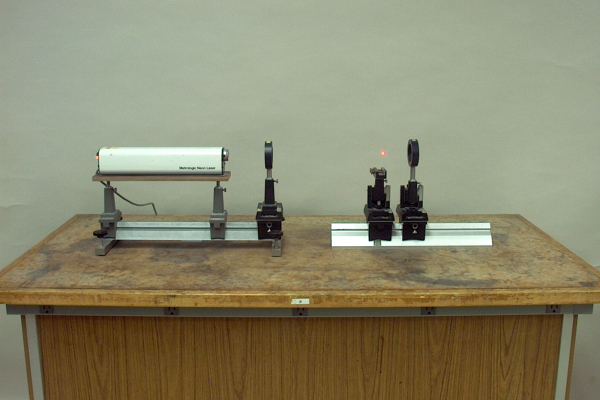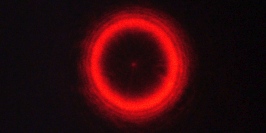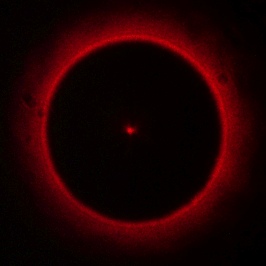 |
 |
 |
 |
 |
 |
Light from a laser, diffracted by a small ball bearing, produces a bright spot in the center of the shadow of the ball bearing. This is known as Poisson’s spot, Fresnel’s spot or Arago’s spot, and is shown in the photographs on the left. The top photograph is of the pattern formed by the ball bearing alone. The bottom photograph shows the image of the diffraction pattern that is formed by a converging lens (100-mm focal length) placed after the ball bearing.
As is shown in 84.06 – Laser beam diffracted through various slits, and 84.09 – Laser beam diffracted by a razor blade, when light passes near the edge of an object, it is bent, or diffracted. This behavior and the patterns that it produces are associated with waves, and only a wave model can describe them both quantitatively and qualitatively. An interesting consequence of this behavior is shown in this demonstration. This is that light diffracted around a circular object – a disc or sphere, produces a bright spot at the center of the shadow cast by the object.
This phenomenon was first observed in 1715 by Joseph-Nicola Delisle, and in 1723 by Giacomo Filippo Maraldi, but apparently this went largely unnoticed until almost a century later. In 1818, as an entry for a prize competition, Augustin Fresnel submitted a paper to the French Academy of Sciences. In this paper about the diffraction of light, Fresnel proposed a wave theory of light that was based on, and an improvement of, Huygens’ wave theory. On the prize committee were François Arago, Siméon Poisson and Pierre-Simon LaPlace, all of whom were proponents of the corpuscular theory of light. Poisson noted that Fresnel’s theory predicted that there should be a bright spot in the center of the shadow of a circular object (which Fresnel had not done). He thought that this was absurd, and proof that the theory was faulty. Shortly thereafter, Arago performed an experiment by which he was able to observe this bright spot, and thus confirmed Fresnel’s prediction. (Arago noted later that Delisle and Maraldi had observed this phenomenon earlier.) The committee awarded Fresnel the prize. Despite this experimental confirmation, Poisson was still not convinced of the validity of the wave theory of light, and remained an adherent of Newton’s corpuscular theory until his death.
As noted above, people commonly use any of three names to refer to this spot. Ironically, perhaps the name used most often is “Poisson’s spot,” after the person who denied its existence. Probably used almost as frequently is “Fresnel’s spot,” after the person whose theory predicted its existence. The third name in common use is “Arago’s spot,” after the one who verified its existence.
References:
1) Halliday, David and Resnick, Robert. Physics, Part Two, Third Edition (New York: John Wiley and Sons, 1977), pp. 1041-2.
2) https://www.aps.org/publications/apsnews/201607/physicshistory.cfm.
3) Englert, Berthold-Georg. Lectures on Classical Electrodynamics (Singapore: World Scientific Publishing Co. Pte. Ltd, 2014), p. 179.
4) American Journal of Physics 52 243 (1984).
5) American Journal of Physics 77 713 (2009).
6) The Physics Teacher 35 18 (1997).